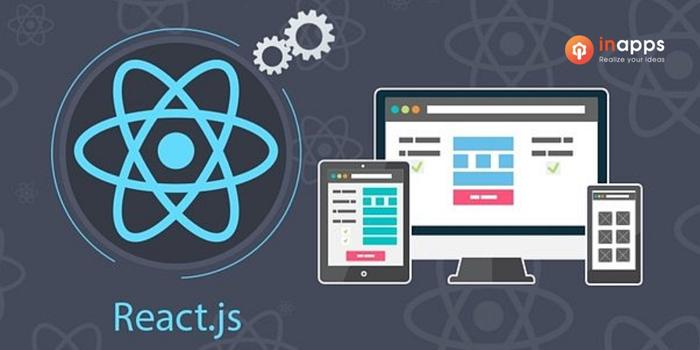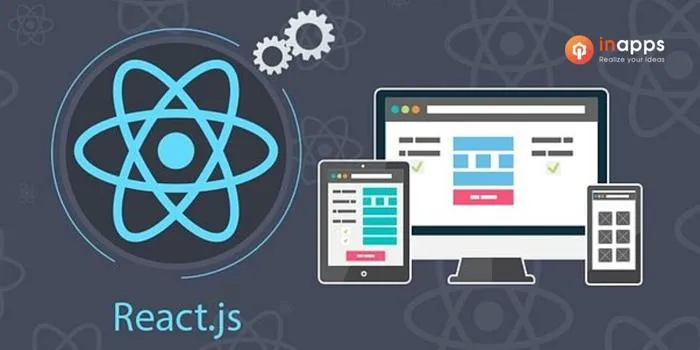As of today, React JS is used to develop the user interfaces of over 8,000 top websites globally. Among them are two social media giants Facebook and Instagram. React JS is so popular thanks to its ability to create user interfaces that are both engaging and performance-efficient.
To help you answer the question Is React.js a Framework, let’s dive into What is react js, react JS app examples, and the distinguished features that this library holds.
1. Is React.js a Framework? What is React JS?
1.1 Is React.js a Framework?
The answer is no. React JS is an open-source JavaScript library that is used for building user interfaces, also for single-page applications. It is used for handling the view layer for web and mobile apps. React allows us to create reusable UI components. It allows developers to create amazing web applications which can change data, without reloading. The main purpose of React is to be scalable, fast, as well as simple.
As you may know, it only works on user interfaces in the application, and this corresponds to the view in the MVC (Model-View-Controller) template. It can be used with a combination of other JavaScript libraries or frameworks, such as Angular JS in MVC.
1.2 Why Is React.js NOT a Framework?
There’s been a lot of debate on Reddit and Quora regarding whether React.js is a Framework or a Library. All in all, if React.js a Framework, it must satisfy the following requirements:
- Provision of Tools and Templates: Frameworks provide ready-to-use tools, standards, and templates that aid in rapid application development. Libraries, on the other hand, typically do not offer.
- Control Flow: In a framework, the control flow is inverted; the framework controls the flow and calls your code. Meanwhile, libraries allow you to control the flow of the application.
- Guidance on Code Structure: Frameworks offer rules and guidelines on how to write code and structure files and folders. They maintain consistency with APIs, compilers, toolsets, and libraries within the framework.
- Calling Mechanism: Frameworks control the calling of libraries for your code
React is a library and not a framework because it does not meet these criteria. It’s more open-ended, provides fewer opinions, and can be used in a variety of ways. Besides, React JS offers less control over the application’s flow and structure to be considered a framework.

2. Features of ReactJS library
So now you know the answer to the question “Is React.js a Framework”. Let’s explore some of the prominent features React JS has.
JSX
It uses JSX as it is simple JavaScript which allows HTML quoting and uses these HTML tag syntax to render subcomponents. Rather than using Angular JS. As well as, HTML syntax processed into JavaScript calls of React Framework.
React Native
React native libraries announced by Facebook in 2015, provide the react architecture to native applications like IOS, Android, and UPD.
Single-Way data flow
In React, a set of immutable values is passed to the components renderer as properties in its HTML tags. Also, the component cannot directly modify any properties but can pass a callback function with the help of which we can do modifications. And this complete process is known as “properties flow down; actions flow up”.
Virtual Document Object Model
React creates an in-memory data structure cache that computes the changes made and then updates the browser. This allows a special feature that enables the programmer to code as if the whole page to rendered on each change, whereas the React library only renders components that change.
Read more: Why React so popular for Front-end Development? Top 9 reasons
3. What is React JS library used for
What does react js do, you may ask?
Being a front-end library, React plays a crucial role in the ‘view layer’ of applications. The view layer specifically deals with the visual output of the application – essentially, what users see and interact with on their screens. For instance, when you rate a service with stars, you’re interacting with a UI element that could be developed using React JS. This library builds these interactive website elements.
React has gained widespread popularity in the JavaScript community for modern web development. It is different from other JavaScript frameworks thanks to its unique approach to building and managing UI components.
In React, the user interface (UI) is built using components. These components are self-contained, reusable pieces of code that represent a part of the UI. This could be as small as a button or as complex as an entire form or navigation menu. Thanks to its component-based approach, React JS allows developers to create distinct UI components that can be reused and managed independently.
Besides, React uses a Virtual DOM (Document Object Model), a lightweight copy of the actual DOM. The Virtual DOM allows React to optimize updates to the real DOM. When a component’s state changes, React first updates the Virtual DOM. Then, using a diffing algorithm, it determines the most efficient way to update the real DOM to match the Virtual DOM. This results in faster and more efficient UI updates.
Lastly, React introduces JSX, a syntax extension that allows HTML to be written within JavaScript code. This makes the structure of the component more readable and visually similar to the layout of the UI it represents. Although JSX is not mandatory, it is widely used in React development because it’s simple and readable.
4. React JS library Examples
React JS is used to build a wide range of user interfaces, from single-page applications, dynamic web forms, and dashboards to e-commerce sites, social platforms, and mobile apps. The list goes on. But now, let’s take a look at the 5 most popular JS examples so far.

The Facebook website, including its dynamic News Feed, notifications, comments, and various interactive elements, is built with React. It’s one of the largest and most complex SPAs (Single Page Applications) in existence.
In case you don’t know what a single-page application is. It is the place where the entire application content is loaded on a single webpage. When you navigate through different sections of the site, the content is dynamically updated without refreshing the page. Examples include Gmail, Google Maps, and Facebook’s news feed.
![]()
Owned by Facebook, Instagram is another significant React JS example application. React js plays a key role in the web version of Instagram, handling the UI for features like the feed, stories, direct messages, and real-time updates.
WhatsApp Web

The web of WhatsApp is another React JS example application. React helps in managing the real-time chat interface, including message display, status updates, and notifications.
Airbnb

Airbnb – a leading platform in the travel industry, uses React to create its dynamic and responsive UI. React aids in handling various features like property listings, user reviews, search functionality, and booking flows.
Netflix

Being a leader in the streaming service industry, Netflix utilizes React js for its front-end development on various platforms. React’s performance benefits and modular component structure can handle the complex user interfaces of Netflix like a pro, including movie listings, searches, recommendations, and user account management.
These are the 5 most common React JS app examples currently in the market. There are many more React JS app examples.
Check out: Best ReactJS Projects for Beginners
5. FAQs on React js library
5.1 What is the difference between react and react js?
React and React JS are essentially the same. Both terms refer to the same JavaScript library used for building user interfaces, particularly single-page applications. The name “React” is often used when discussing concepts broadly, while “React JS” explicitly highlights that it is a JavaScript library. This distinction is usually made for clarity, especially when differentiating from React Native, a related technology for mobile app development.
5.2 What is the difference between React JS and React native?
While React JS is used for web development, React Native is used for mobile app development.
More specifically, React Native is used for building mobile applications for iOS and Android platforms with a single codebase. Unlike React JS, which outputs to the web, React Native’s components compile to native mobile app components, offering a native app experience.
5.3 Is ReactJS different from JavaScript?
JavaScript is a programming language that is one of the core technologies of the World Wide Web, HTML, and CSS. ReactJS, on the other hand, is a library built in JavaScript to help developers build web applications more efficiently.
6. Wrapping Up: Is React.js a Framework?
In conclusion, it can’t be denied that React JS stands as a powerful and versatile JavaScript library that has changed the way we build web applications. Its component-based architecture makes it easier to develop and enhance the user experience. The use of a virtual DOM optimizes performance, making React an ideal choice for complex applications like social media platforms, and e-commerce sites. React js can integrate seamlessly with other technologies and its vast ecosystem of tools, perfect for creating modern, scalable web applications.
As we continue to advance in the digital age, the significance of React JS in shaping the future of web development is here to stay. It empowers developers to build efficient, intuitive, and engaging web applications, making it a cornerstone technology in the realm of web development.
I hope this article answers your questions on whether is React.js a Framework. If you want to hire skilled React js developers on a budget, check out the last section!
Hire React JS developers with InApps Technology

The hiring process of InApps to hire React JS developers is hard, but InApps Team makes it easy.
We boast a team of seasoned React JS developers who are not just adept at React JS but also excel in aligning with your unique business needs. Concerned about project timelines, quality, or maintaining industry standards? Our InApps developers are here to alleviate those worries. We bring you a perfect blend of innovation, commitment, and technical excellence to the table, ensuring your project is not just completed, but masterfully executed.
Let’s create the next big thing together!
Coming together is a beginning. Keeping together is progress. Working together is success.




















